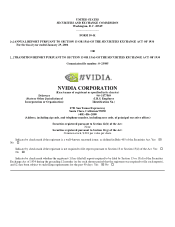NVIDIA 2006 Annual Report Download - page 11
Download and view the complete annual report
Please find page 11 of the 2006 NVIDIA annual report below. You can navigate through the pages in the report by either clicking on the pages listed below, or by using the keyword search tool below to find specific information within the annual report.
and deliver innovative technologies for networking, storage and system performance. NVIDIA nForce4 products are designed to
provide a combination of SLI technology and PCI Express support for Intel and AMD64 and Opteron−based platforms. In April 2005,
we announced the availability of our NVIDIA nForce4 SLI Intel Edition MCP for Intel−based platforms. This line of core−logic
solutions incorporates a host of new and innovative features that had never before been available on the Intel platform and extended
the NVIDIA nForce brand into new segments. In June 2005, we made our SLI technology available to users in the mainstream
segment with the release of our GeForce 6600 GPU. In August 2005, we announced that the NVIDIA nForce4 SLI X16 Intel Edition
technology featured in the Dell Dimension XPS 600 desktop PC was immediately available. In September 2005, we introduced our
first motherboard graphics solutions in more than two years, the GeForce 6100 Series GPU and NVIDIA nForce 400 Series MCP. We
offer the industry's first and only integrated core logic to feature DirectX 9.0 and Shader Model 3.0 technology. In January 2006, we
announced two new MCPs for the Intel platform, the NVIDIA nForce4 SLI XE and NVIDIA nForce4 Ultra, both of which provide the
system−builder and do−it−yourself communities with two new lower cost discrete motherboard solutions for Intel PC platforms.
Handheld GPUs. Our Handheld GPU product family, known as GoForce, supports handheld personal digital assistants, or PDAs,
and multimedia cellular phones.
GoForce. The GoForce family represents our handheld GPUs for a wide range of multimedia cellular phones and handheld
devices. The GoForce 2100 and GoForce 2150 GPUs are two of the first handheld GPUs to offer hardware acceleration engines for
2D graphics to manufacturers that support liquid crystal display, or LCD, screen resolutions up to 320 x 240 pixels. The GoForce 3000
and GoForce 4000 offer a host of advanced features for cellular phones and PDAs, including support for up to 3−megapixel image
capture, accelerated graphics for gaming, and motion Joint Photographic Experts Group, or JPEG, capture and playback. Our
GoForce 4000, GoForce 4500 and GoForce 4800 handheld GPUs are the first to provide programmable 3D shaders, along with
high−quality multi−megapixel still image and video processing in a single−chip package. Using dedicated hardware accelerator
engines, the GoForce family delivers high performance multimedia applications and drives high−resolution displays, while extending
handheld battery life through a variety of unique power management techniques. In the third quarter of fiscal 2006, Motorola Inc. and
Sony Ericsson Mobile Communications AB launched Third Generation, or 3G, models of their RAZR and Walkman portable phones,
respectively, that are both powered by our GoForce GPUs.
Consumer Electronics. Our Consumer Electronics product group is concentrated in products that support video game consoles
and other digital consumer electronics devices.
Playstation3. In April 2005, we finalized our definitive agreement with SCE to jointly develop a custom GPU incorporating our
next−generation GeForce GPU and SCE's system solutions in SCE's PlayStation3. In addition, we are licensing software development
tools for creating shaders and advanced graphics capabilities to SCE. We have successfully reached many development milestones and
we believe that we are on target to achieve the goals set by SCE under this agreement.
Xbox. Our Xbox platform processor supported Microsoft's initial Xbox video game console. The Xbox platform processor
featured dual−processing architecture, which included our GPU designed specifically for the Xbox, or XGPU, and our MCP to power
the Xbox's graphics, audio and networking capabilities. We also have a license agreement with Microsoft relating to the successor
product to their initial Xbox gaming console, the Xbox360, and related devices. During the first quarter of fiscal 2006, Microsoft
indicated that it would not order any more Xbox−related products from us after our second fiscal quarter. As a result, the second
quarter of fiscal 2006 was the last quarter during which we recognized revenue from the sale of our Xbox−related products to
Microsoft.
Our Strategy
We design our GPUs, MCPs and handheld GPUs to enable our PC OEMs, ODMs, system builders, motherboard and add−in
board manufacturers, and cellular phone and consumer electronics OEMs, to build award−winning products by delivering
state−of−the−art features, performance, compatibility and power efficiency while maintaining competitive pricing and profitability.
We believe that by developing 3D graphics, HD video and media communications solutions that provide superior performance and
address the key requirements of each of the product segments we serve, we will accelerate the adoption of HD digital media platforms
and devices throughout these segments. We combine scalable architectural technology with mass market economies−of−scale to
deliver a complete family of products that spans professional workstations, to consumer PCs, to mulitmedia−rich cellular phones.
5
























